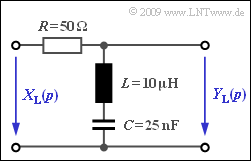Exercise 3.3: p-Transfer Function
Any linear time-invariant system that can be realized by a circuit of discrete time-constant components (resistances $R$, capacitances $C$, inductances $L$, amplifier elements, etc.) is causal and also has a fractional–rational $p$–transfer function of the form
- $$H_{\rm L}(p)= \frac {A_Z \cdot p^Z +\text{ ...} + A_1 \cdot p + A_0} {B_N \cdot p^N + \text{ ...} + B_1 \cdot p + B_0}= \frac {Z(p)}{N(p)} \hspace{0.05cm} .$$
- All coefficients $A_Z$, ... , $A_0$, $B_N$, ... , $B_0$ are real.
- $Z$ denotes the degree of the numerator polynomial $Z(p)$.
- $N$ denotes the degree of the denominator polynomial $N(p)$ .
An equivalent representation form of the above equation is:
- $$H_{\rm L}(p)= K \cdot \frac {\prod\limits_{i=1}^Z p - p_{\rm o i}} {\prod\limits_{i=1}^N p - p_{\rm x i}}= K \cdot \frac {(p - p_{\rm o 1})(p - p_{\rm o 2})\cdot \text{ ...} \cdot (p - p_{{\rm o} \hspace{-0.03cm} Z})} {(p - p_{\rm x 1})(p - p_{\rm x 2})\cdot \text{ ...} \cdot (p - p_{{\rm x} \hspace{-0.03cm} N})} \hspace{0.05cm} .$$
The $Z + N + 1$ parameters mean:
- $K = A_Z/B_n$ is a constant factor. If $Z = N$ applies, then this is dimensionless.
- The solutions of the equation $Z(p) = 0$ yield the $Z$ zeros $p_{{\rm o}1}$, ... , $p_{{\rm o}N}$ of $H_{\rm L}(p)$.
- The zeros of the denominator polynomial $N(p)$ yield the $N$ poles $p_{{\rm x}1}$, ... , $p_{{\rm x}N}$ of the transfer function.
These characteristics are to be determined for the circuit shown in the diagram with the following components:
- $$R = 50\,\,{\rm \Omega}\hspace{0.05cm},\hspace{0.2cm} L = 10\,\,{\rm µ H}\hspace{0.05cm},\hspace{0.2cm}C = 25\,\,{\rm nF}$$
Additionally, the Fourier frequency response $H(f)$ is to be determined which arises as a result from $H_{\rm L}(p)$ by the substitution $p= {\rm j } \cdot 2\pi f$ .
Please note:
- The exercise belongs to the chapter Laplace Transform and p-Transfer Function.
- The following are the auxiliary quantities used in this exercise:
- $$A = \frac{R}{2L}\hspace{0.05cm},\hspace{0.2cm} B = \frac{1}{\sqrt{LC}}\hspace{0.05cm} .$$
Questions
Solution
- $$H_{\rm L}(p)= \frac {pL +{1}/{(pC)}} {R + pL + {1}/{(pC)}}= \frac { p^2 \cdot{LC}+1} {p^2 \cdot{LC} + p \cdot{RC}+ 1} \hspace{0.05cm} .$$
- Die beiden gewünschten Grenzübergänge ergeben sich zu
- $$\underline {H_{\rm L}(p \rightarrow 0)= 1, \hspace{0.2cm}H_{\rm L}(p \rightarrow \infty)= 1} \hspace{0.05cm} .$$
- Daraus folgt, dass es sich weder um einen Tiefpass noch um einen Hochpass handeln kann.
- Sowohl bei sehr niedrigen als auch bei sehr hohen Frequenzen gilt $y(t)=x(t)$.
(2) Richtig ist der Lösungsvorschlag 2:
- Ersetzt man $p$ durch ${\rm j } \cdot 2\pi f$, so erhält man
- $$H(f)= \frac {1 - (2\pi f)^2 \cdot LC} {1 - (2\pi f)^2 \cdot LC + {\rm j} \cdot 2\pi f \cdot RC} \hspace{0.05cm} .$$
- Es gibt also stets eine Frequenz, bei der der Zähler Null ist, nämlich die Resonanzfrequenz von $L$ und $C$.
- Für diese Frequenz $f_0 = 1 \ \rm MHz/2\pi$ wirkt die Reihenschaltung von $L$ und $C$ wie ein Kurzschluss.
- Daraus folgt: Unabhängig von den Werten von $R$, $L$ und $C$ handelt es sich um eine $\rm Bandsperre$.
(3) Entsprechend dem Angabenblatt gilt:
- $$A = \frac{R}{2L}= \frac{50\,{\rm \Omega}}{2 \cdot 10\,{\rm \mu H}} = \frac{50\,{\rm \Omega}}{2 \cdot 10^{-5 }\,{\rm \Omega s}}\hspace{0.15cm} \underline {= 2.5} \cdot 10^6 \, \,{1}/{\rm s}\hspace{0.05cm},$$
- $$ B = \frac{1}{\sqrt{LC}} = \frac{1}{\sqrt{10^{-5 }\,{\rm \Omega s} \cdot 25 \cdot 10^{-9 }\,{\rm s/\Omega }}}\hspace{0.15cm} \underline {= 2.0} \cdot 10^6 \, \,{1}/{\rm s}\hspace{0.05cm} .$$
(4) Mit $A=R/(2L)$ und $B^2 = 1/(LC)$ erhält man aus der in der Teilaufgabe (1) ermittelten $p$–Übertragungsfunktion:
- $$H_{\rm L}(p)= \frac { p^2 + {1}/(LC)} {p^2 + p \cdot{R}/{L} +{1}/(LC)} = \frac { p^2 + B^2} {p^2 + 2A \cdot p + B^2} \hspace{0.05cm} .$$
- Das Zählerpolynom $Z(p)$ und das Nennerpolynom $N(p)$ sind jeweils quadratisch ⇒ $\underline {Z = N = 2}$.
- Der konstante Faktor ergibt sich zu $\underline {K = 1}$.
(5) Die Lösung der Gleichung $p^2 + B^2 = 0$ führt zum Ergebnis $p = \pm {\rm j} \cdot B$ und damit zu den Nullstellen
- $${\rm Re}\{ p_{\rm o1}\} \underline {= 0}\hspace{-0.3cm} \hspace{1cm}{\rm Im}\{ p_{\rm o1}\} \underline {=+2.5} \cdot 10^6 \, {1}/{{\rm s}} \hspace{0.05cm},$$
- $$ {\rm Re}\{ p_{\rm o2}\}\hspace{0.15cm} \underline { = 0}\hspace{-0.3cm} \hspace{1cm}{\rm Im}\{ p_{\rm o2}\} \underline {=-2.5} \cdot 10^6 \, {1}/{{\rm s}} \hspace{0.05cm}.$$
- Die Normierung der Variablen $p$ und aller Pole und Nullstellen auf die Einheit $( \rm 1/µ s)$ vereinfacht die numerische Auswertung, insbesondere im Zeitbereich.
- Verzichtet man auf die Einheit ganz, so ergeben sich alle $t$–Werte in Mikrosekunden.
(6) Setzt man das Nennerpolynom $N(p) = 0$, so ergibt sich folgende Bestimmungsgleichung:
- $$p^2 + 2A \cdot p + B^2 = 0 \hspace{0.3cm}\Rightarrow \hspace{0.3cm} p_{\rm x1,\hspace{0.05cm}2}= -A \pm \sqrt{A^2 - B^2} \hspace{0.05cm},$$
- $${\rm Mit}\hspace{0.2cm}A = 2.5 \cdot 10^6 \cdot {1}/{\rm s}\hspace{0.05cm},\hspace{0.2cm} \sqrt{A^2 - B^2}= 1.5 \cdot 10^6 \cdot {1}/{{\rm s}}\hspace{0.05cm}:$$
- $${\rm Re}\{ p_{\rm x1}\}\hspace{0.15cm} \underline {= -1} \cdot 10^6 \cdot {1}/{{\rm s}}\hspace{0.15cm} \underline {= -1} \cdot {1}/{{\rm \mu s}}, \hspace{0.2cm}{\rm Im}\{ p_{\rm x1}\}\hspace{0.15cm} \underline { = 0} \hspace{0.05cm},$$
- $${\rm Re}\{ p_{\rm x2}\}\hspace{0.15cm} \underline {= -4} \cdot 10^6 \cdot {1}/{{\rm s}}\hspace{0.15cm} \underline {= -4} \cdot {1}/{{\rm \mu s}}, \hspace{0.2cm}{\rm Im}\{ p_{\rm x1}\}\hspace{0.15cm} \underline { = 0} \hspace{0.05cm}.$$
Dieses Ergebnis ist nur eindeutig unter Berücksichtigung der Angabe $|p_\text{x2}| > |p_\text{x1}|$.
(7) Richtig ist der Lösungsvorschlag 1:
- Da man nur eines der Bauelemente ändern soll, müssen $L$ und $C$ gleich bleiben, da sonst auch die Nullstellen verschoben würden.
- Man muss den Widerstandswert $R$ ändern.
(8) Entsprechend dem Ergebnis aus (7) ergibt sich eine doppelte Polstelle für $\underline {A = B = 2 \cdot 10^{-6} \cdot \rm 1/s}$.
- Dazu muss der Ohmsche Widerstand von $50 \ \rm \Omega$ auf $40 \ \rm \Omega$ herabgesetzt werden.
- Der doppelte Pol liegt dann bei ${-2 \cdot 10^{6} \cdot \rm 1/s}$.
- Oder bei anderer Normierung bei ${-2 \cdot \rm (1/µ s)}$.
